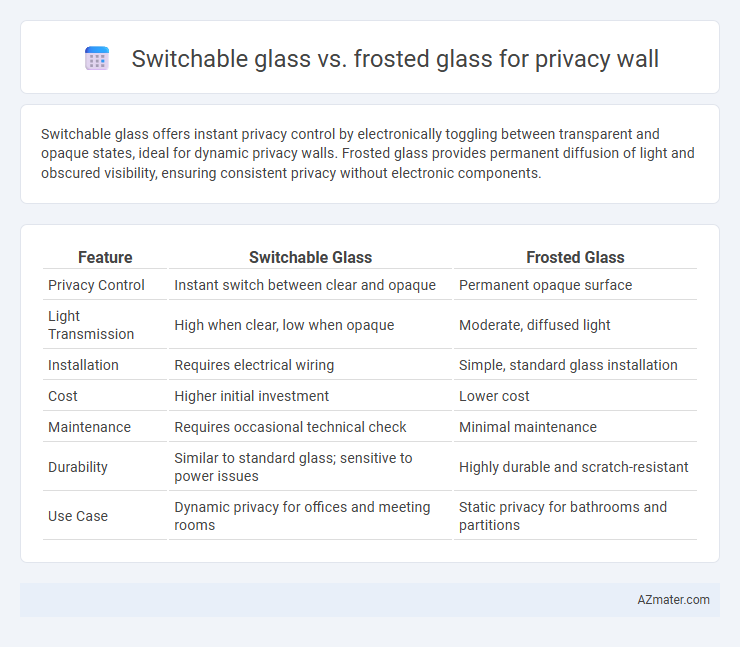Switchable glass offers instant privacy control by electronically toggling between transparent and opaque states, ideal for dynamic privacy walls. Frosted glass provides permanent diffusion of light and obscured visibility, ensuring consistent privacy without electronic components.
Table of Comparison
| Feature | Switchable Glass | Frosted Glass |
|---|---|---|
| Privacy Control | Instant switch between clear and opaque | Permanent opaque surface |
| Light Transmission | High when clear, low when opaque | Moderate, diffused light |
| Installation | Requires electrical wiring | Simple, standard glass installation |
| Cost | Higher initial investment | Lower cost |
| Maintenance | Requires occasional technical check | Minimal maintenance |
| Durability | Similar to standard glass; sensitive to power issues | Highly durable and scratch-resistant |
| Use Case | Dynamic privacy for offices and meeting rooms | Static privacy for bathrooms and partitions |
Introduction to Privacy Glass Solutions
Switchable glass offers advanced privacy by electronically changing from transparent to opaque with the flick of a switch, providing instant control over visibility. Frosted glass provides a permanent, translucent surface that diffuses light while obscuring view, ideal for consistent privacy without mechanical components. Both solutions serve as effective privacy wall options, with switchable glass emphasizing dynamic functionality and frosted glass focusing on static, cost-effective obscuration.
What is Switchable Glass?
Switchable glass, also known as smart glass, is an innovative privacy solution that changes from transparent to opaque with the flick of a switch, using liquid crystal technology to control light transmission. Unlike frosted glass which provides a fixed level of privacy through its permanent textured surface, switchable glass offers dynamic privacy control, making it ideal for conference rooms, offices, and residential partitions. This adaptability enhances design flexibility, energy efficiency, and user convenience compared to conventional frosted glass privacy walls.
Features of Frosted Glass
Frosted glass provides consistent privacy by diffusing light and obscuring visibility through its textured, sandblasted surface, making it ideal for partitions and privacy walls. Its durability and low maintenance require no electrical components or special installations, unlike switchable glass, ensuring long-term privacy without energy consumption. Frosted glass also enhances aesthetic appeal by offering a sleek, modern look that integrates seamlessly with various interior designs.
Privacy Levels: Switchable vs Frosted Glass
Switchable glass offers dynamic privacy control by instantly toggling between transparent and opaque states, providing adjustable visibility on demand. Frosted glass provides a permanent, diffuse surface that obscures visibility but lacks flexibility in privacy levels. Switchable glass delivers superior privacy customization, making it ideal for spaces requiring variable discretion, while frosted glass suits environments with consistent privacy needs.
Aesthetic Differences and Design Flexibility
Switchable glass offers a modern aesthetic with a sleek, transparent-to-opaque transition that enhances contemporary privacy wall designs through dynamic light control. Frosted glass provides a consistent matte finish that diffuses light while ensuring permanent privacy, ideal for classic or minimalist interiors. The design flexibility of switchable glass supports customizable transparency levels and remote operation, whereas frosted glass relies on static patterns and textures for visual appeal.
Cost Comparison: Switchable vs Frosted Glass
Switchable glass typically costs between $80 to $120 per square foot, significantly higher than frosted glass, which ranges from $25 to $50 per square foot, making frosted glass more budget-friendly for privacy walls. Installation expenses for switchable glass are also higher due to the need for electrical components and specialized labor, whereas frosted glass requires standard glazing techniques. Long-term costs favor frosted glass as it entails no energy consumption or maintenance fees unlike switchable glass, which demands power and occasional repairs.
Installation and Maintenance Requirements
Switchable glass installation requires integration with electrical wiring and a compatible control system, making it more complex and costly compared to frosted glass, which involves standard glazing techniques without electrical components. Maintenance for switchable glass includes periodic checks of the electrical and control systems to ensure functionality, while frosted glass demands only routine cleaning with no special upkeep. The electrical dependency of switchable glass can lead to higher long-term maintenance costs, whereas frosted glass offers a low-maintenance, durable solution for privacy walls.
Energy Efficiency and UV Protection
Switchable glass offers superior energy efficiency by regulating light transmission and reducing heat gain, thus lowering HVAC costs compared to frosted glass. It provides enhanced UV protection by blocking up to 99% of harmful ultraviolet rays, preserving interior furnishings and reducing glare. Frosted glass, while offering consistent privacy, lacks dynamic control over solar heat and UV radiation, resulting in less effective energy savings and UV defense.
Durability and Longevity
Switchable glass features advanced electrochromic technology that enhances durability through scratch-resistant coatings and UV protection, ensuring longevity in privacy wall applications. Frosted glass, while sturdy and resistant to wear, is more prone to surface scratches and discoloration over time due to its etched or sandblasted finish. Both options offer robust performance, but switchable glass typically outperforms frosted glass in maintaining clarity and privacy benefits over extended periods.
Best Applications for Each Glass Type
Switchable glass excels in office conference rooms and modern homes where instant privacy control and light transmission adjustments are crucial, enabling seamless transitions between transparent and opaque states. Frosted glass is ideal for bathrooms, partitions, and decorative privacy walls where constant diffused light and permanent obscured views are needed without electronic intervention. Choosing between switchable and frosted glass depends on the need for dynamic visibility control versus static privacy and aesthetic preferences.

Infographic: Switchable glass vs Frosted glass for Privacy wall
 azmater.com
azmater.com